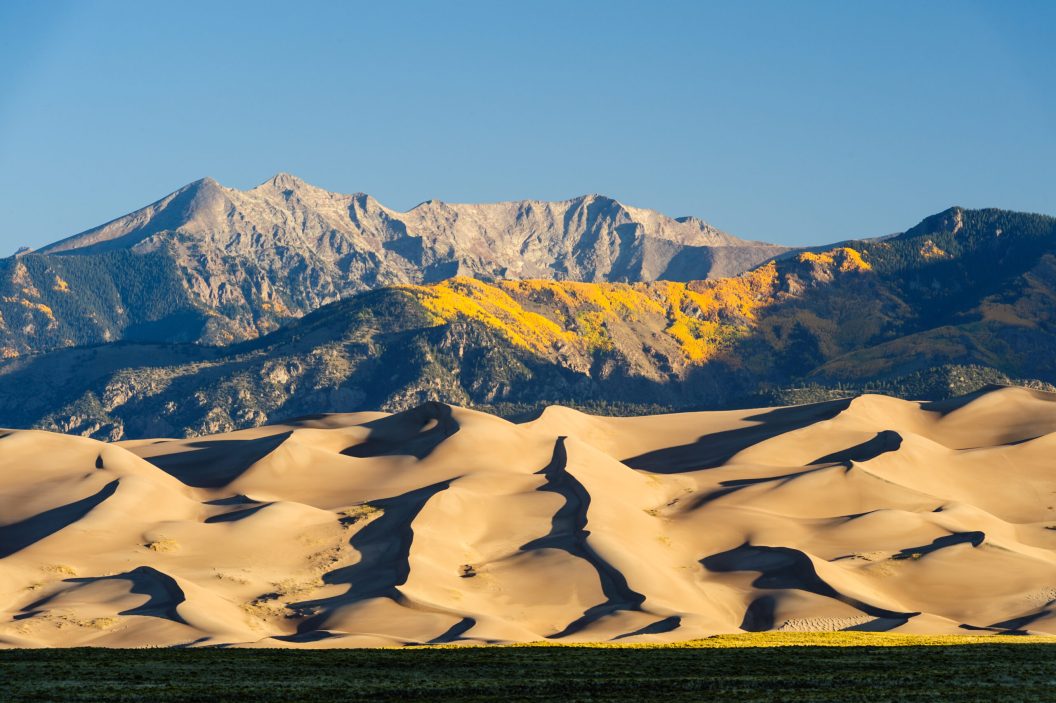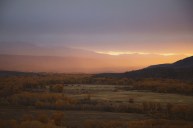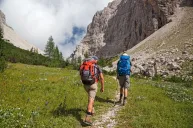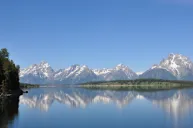Colorado's four National Parks are each distinct places of natural wonder and recreation.
There are campsites to get cozy in under a sparkling indigo sky, whitewater rafting trips to get thoroughly soaked on, rock walls to scale, fish to catch, boundless open space to explore, and so much more.
With the four sites, Rocky Mountain, Black Canyon of the Gunnison, Great Sand Dunes, and Mesa Verde, evenly dispersed across the state, there are so many reasons to visit Colorado.
Rocky Mountain National Park
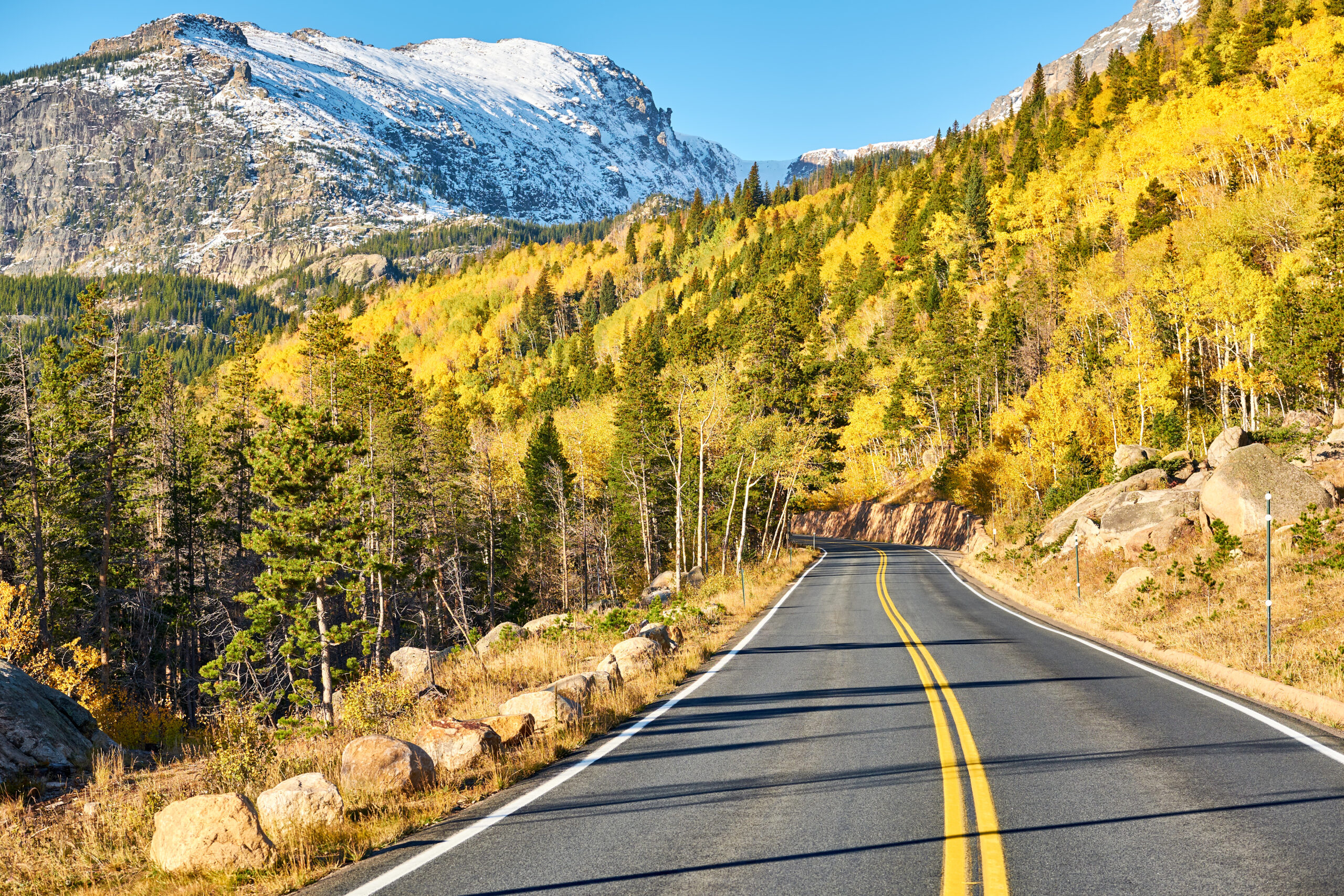
Highway at autumn sunny day in Rocky Mountain National Park via Getty Images
Rocky Mountain is arguably the most popular National Park in Colorado. It boasts about 4.5 million visitors annually, making it the sixth-most visited park in America. Located northwest of Boulder and Denver, the park is sandwiched between Estes Park and Grand Lake, Colorado and is approximately 415 square miles of mountain wilderness.
If the scenery does not take your breath away, the altitude will. There are over 300 miles of hiking trails and some of them at elevations as high as 12,000 feet. Hikers are advised to eat your Wheaties before you go! For more adventuresome hikers, the park offers overnight wilderness camping opportunities. Just be advised that such a trip does require a permit. The two visitor centers can help with that.
The park has five campgrounds, mostly for tent-only access. There are additional private campgrounds and lodging outside the park's boundaries in Estes Park and Grand Lake. Expect more options in Estes Park, but also higher prices.
For the rock climbers out there, consider the Keyhole Route to the top of Longs Peak, which towers above the rest of the park at 14,259 feet in elevation. This is a serious challenge for climbers and requires specialized safety gear to conquer the steep sheer rock faces on the route.
For those looking for something a little less extreme, not to worry. The park offers plenty of scenic drives that will take you past high-altitude fields of wildflowers and expose you to wildlife and high tundra during the warmer months. Consider driving the Trail Ridge Road connecting Estes Park and Grand Lake. It is only 48 miles long, but it will take you to altitudes over 12,183 feet for some of the most spectacular views you will ever see.
There is no shortage of wildlife in Rocky Mountain. Look for elk, bighorn sheep, black bears, mule deer, moose, mountain lions, and more. You may even see a wolverine or a Canada lynx if you are sharp-eyed (and extremely lucky.)
Black Canyon of the Gunnison National Park
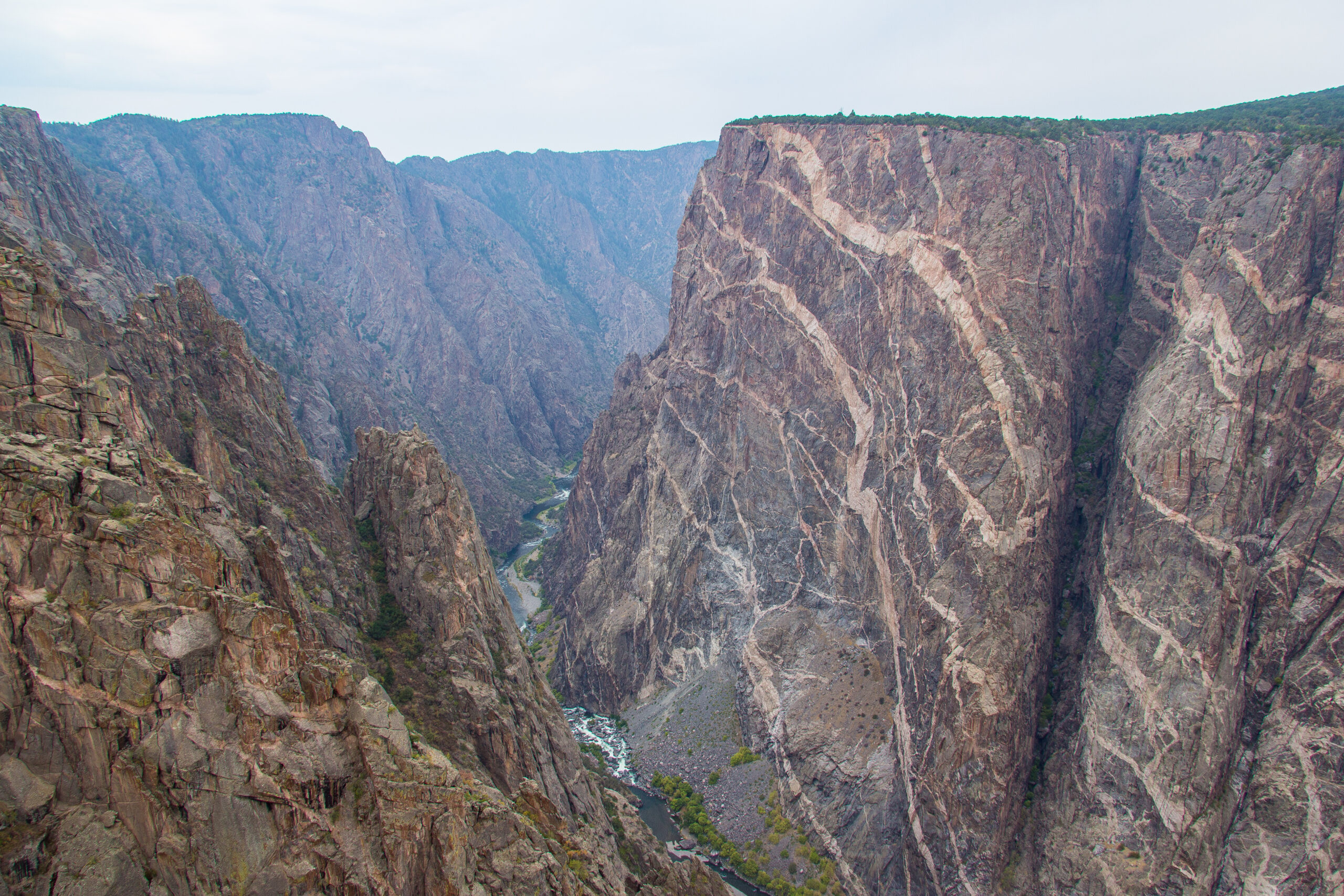
Jagged rocks and steep cliffs at Black Canyon of the Gunnison National Park in western Colorado via Getty Images
Something of a hidden gem as far as Colorado's National Parks is concerned, Black Canyon was first a National Monument before being upgraded to a National Park in 1999. Black Canyon is located southeast of Grand Junction near Montrose, Colorado. Black Canyon is just as the name suggests, a deep, steep canyon of dark rocks dating back millions of years with the Gunnison River cutting through the middle of it. It is extremely narrow in portions, cutting down the amount of sunlight that gets through, thus the name "Black Canyon."
As for activities, there is no shortage. Go trout fishing in the Gunnison River or take a scenic hike to check out the views. There is something for everyone when it comes to hiking. The south rim has several simple to moderate hikes that should take no more than an afternoon. The north rim has a few more difficult ones like the North Vista Trail which includes a strenuous seven-mile round trip hike to Green Mountain. Those who make it will be treated to some of the most spectacular views in the park.
There is also the option to venture down into the depths of the canyon to take in the towering sheer cliffs from below. However, it should be noted that the NPS requires wilderness use permits for such an adventure. Mainly because the narrowness of the canyon makes a rescue operation difficult for people who take on more than they can handle. Permits are required for anyone who wants to kayak the waters of the river or who wants to try rock climbing on the sheer walls. Rangers recommend having map and compass reading knowledge before venturing to the bottom of the canyon. The steep walls distort GPS signals and can render the devices useless at the bottom.
Gunnison includes three campgrounds, one of which is at the bottom of the canyon. The other two are located on the north and south rims. Space is limited and reservations are recommended. There are no showers available at any of the campgrounds, but the South Rim campground does is equipped with 23 electrical sites. Additional camping is also available in Montrose for those looking to spend a few days exploring the park.
Great Sand Dunes National Park and Preserve
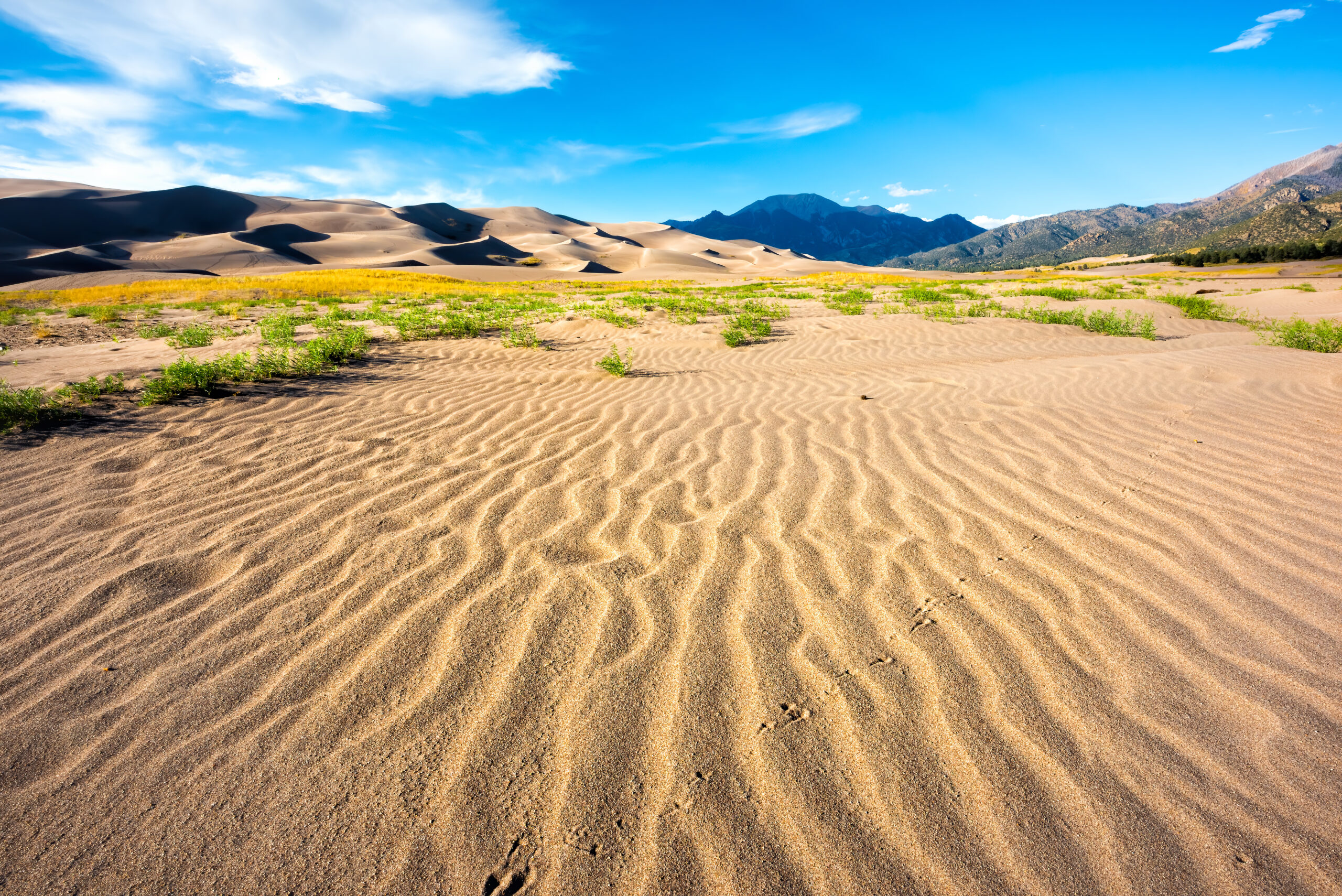
Great Sand Dunes National Park and Preserve in Colorado in autumn fall season wide angle view of landscape and blue sky
Colorado's Great Sand Dunes National Park is home to the tallest sand dunes in North America. Some of them tower as high as 750 feet making for a truly fascinating sight after driving through the rugged peaks of the Rockies in the northern part of the state. Great Sand Dunes is located just outside Alamosa, about an hour north of the New Mexico border and covers about 150,000 acres.
Like Black Canyon, it too started off as a National Monument back in the 1930s before receiving its own National Park designation in 2004. The dunes are part of the greater San Luis Valley and contains about 30 square miles of sand sediments that were deposited into the valley from the mountains over thousands of years.
As with the other parks, there are plenty of opportunities for hiking. Most popular is trekking to the top of the tallest dunes in the park. Star Dune is the tallest at approximately 750 feet. The NPS recommends you set aside at least six to nine hours to complete the approximate eight-mile round trip hike. For off-road enthusiasts, this one of the rare National Parks where you can do some more technical and challenging driving through Medano Pass Primitive Road, a 22-mile scenic stretch. All vehicles must be 4-wheel drive, and some sand and water crossings are to be expected. This road does close at times, so check ahead of time to see the status of it before you go. This park also allows horseback riding, just make sure you brush up on the park's regulations because some areas are closed to horse use.
For family fun, consider cooling off in Medano Creek during the warmer months. This creek is made up of cool, melted snow and is extremely shallow, making it ideal for younger children to splash, surf or skimboard. The other unique family experience is to try sand sledding and sandboarding. It is exactly what it sounds like. Rent a specially-designed board or sled from a local business and then trek up the dunes for the chance to go zipping down them at a high rate of speed. Just keep in mind that the park does not rent these items, you will have to go outside the park's boundaries.
Mesa Verde National Park
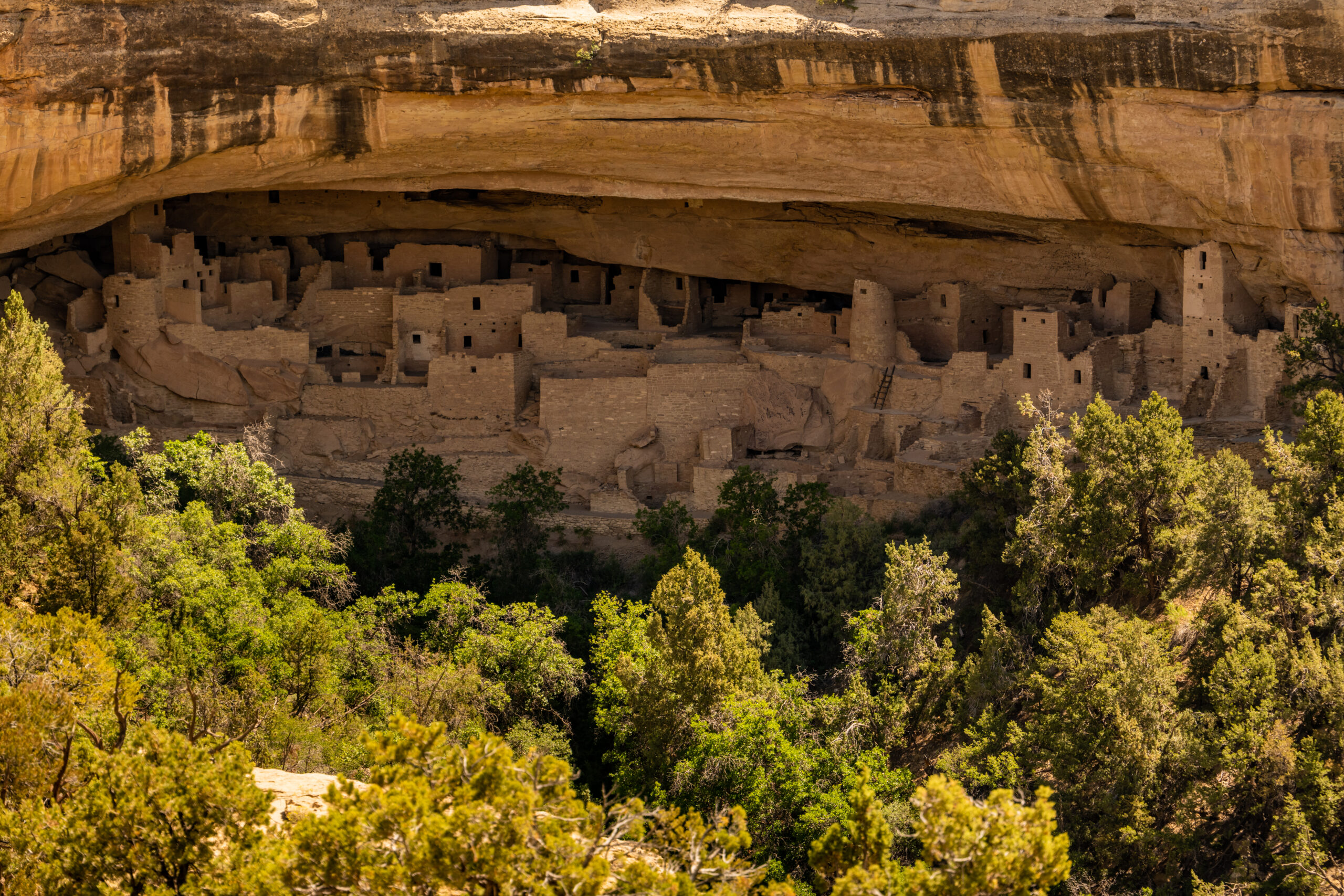
Spruce Tree House Tucked Under Canyon Cliff in Mesa Verde National Park via Getty Images
One of the more unique National Parks in North America, this place is perfect for the history buff. This remote park is situated in southwest Colorado near the town of Cortez. Not only is this spot a National Historic Site it is also a recognized UNESCO World Heritage Site first established by Teddy Roosevelt back in 1906. Mesa Verde was originally inhabited by the ancestral Puebloans who made it their home for more than 700 years. It is not every day one comes across a building that old in North America!
Archaeologists have determined these Native Americans inhabited Mesa Verde from approximately 600 to 1300 CE, and they have discovered more than 5,000 sites of importance to archeology. The main attractions here are the multiple cliff dwellings built by the Pueblos centuries earlier. Today they stand empty and silent, echoes of the past and the many people who used to call the area home. All viewings of these dwellings are done via guided tours with Rangers only to protect the structures. The only exception is Step House, which is self-guided. Reservations are recommended.
The most popular dwelling is the sprawling and incredibly impressive Cliff Palace, which features several overlooks of the multitude of buildings perched under a large outcrop of rock. Be sure to check out the equally impressive Balcony House too. It stirs the imagination just trying to imagine building such impressive buildings without the aid of modern power tools and equipment. Another popular attraction here is the Spruce Tree House, however the trail has been closed for now due to concerns about falling rocks.
In addition to the cliff dwellings, there is plenty of scenery to enjoy on the park's hiking trails. Consider the Spruce Canyon trail or Petroglyph Point trail, a 1.4-mile loop that will show you some ancient petroglyph artwork of the Pueblos. If you are looking to spend several days exploring Mesa Verde, the park does have a single campground called Morefield. According to the NPS website it has 267 sites. Only 15 have electric hookups and are open to RV only. The campground does have a store with supplies, a laundromat, gas, and showers though. The NPS say it is rarely filled to capacity which means it is a quiet place to get away from it all in the high deserts of Colorado.
For more outdoor content from Travis Smola, be sure to follow him on Twitter and check out his Geocaching and Outdoors with Travis YouTube channels.
NEXT: THE AXIS DEER AND HOW THEY'RE IMPACTING PARTS OF THE UNITED STATES
